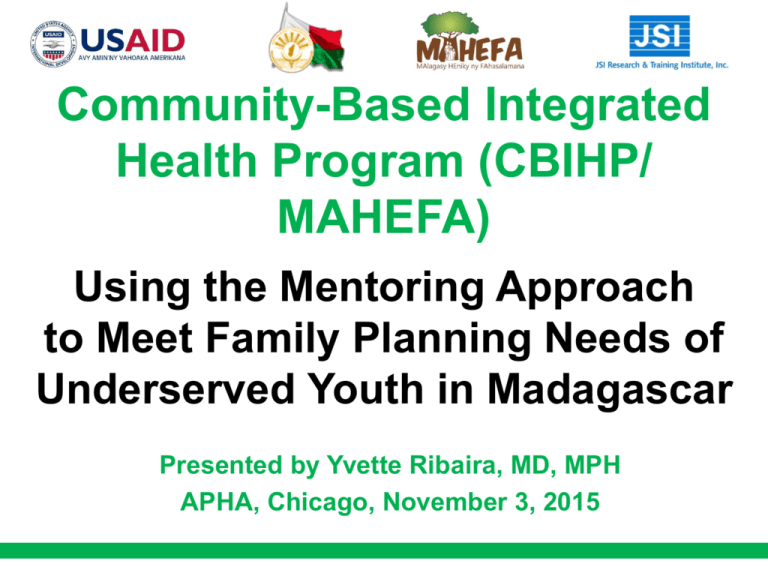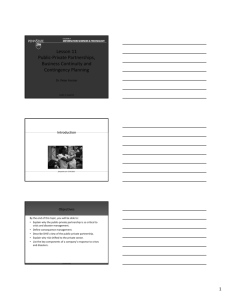Community-Based Integrated Health Program (CBIHP
advertisement

Community-Based Integrated Health Program (CBIHP/ MAHEFA) Using the Mentoring Approach to Meet Family Planning Needs of Underserved Youth in Madagascar Presented by Yvette Ribaira, MD, MPH APHA, Chicago, November 3, 2015 Presenter Disclosures Yvette Ribaira, MD, MPH (1) The following personal financial relationships with commercial interests relevant to this presentation existed during the past 12 months: No relationships to disclose Outline 1. 2. 3. 4. 5. 6. Objective Background Intervention Methodology Key findings Conclusions 1. Objective Describe the community mentoring approach used to increase utilization of family planning and reproductive health (FP/RH) services among youth in Madagascar. 2. Background: Madagascar • 22,434,363 inhabitants with 80% rural and 32% youth (10-24 yrs) • Total Fertility Rate: 4.8; Rural areas: 5.2 • 46% of women 15-24 yrs have given birth, including 26% of youth 15-19 yrs Sources: Madagascar, INSTAT, 2014; DHS, 2008/2009 Trends in Contraceptive Prevalence Rate and Unmet Needs, Madagascar, 1992-2008: 15-49 yrs women in union, 34% 29% % 30% 25% 23% 20% 18% 10% 0% 16% 10% 5% DHS 1992 % 40% 30-34 age group DHS 1997 CPR DHS 2003/04 DHS 2008/09 40% 35% 30% 25% 20% 15% 10% 5% 0% 35% 26% 8% Unmet need CPR Unmet need 30% 25% 22% 18% 17% 10% 9% 5% 22% 20% 20% 20% 15% 27% 24% 25% 28% 17% 15% % % DHS 1997 DHS 2003/04 DHS 2008/09 15-19 age group 27% 10% 11% 5% 3% DHS 1992 15% 12% DHS 1992 31% 30% 0% 24% 20% 20-24 age group 35% 36% DHS 1997 CPR DHS 2003/04 DHS 2008/09 Unmet need Source: Madagascar, DHS, 2008/2009 0% 3% 1% DHS 1992 DHS 1997 DHS 2003/04 DHS 2008/09 CPR Unmet need 2. Background: CBIHP/MAHEFA CBIHP/MAHEFA reaches 3.4 million people in six remote regions (279 communes, 1/5 of national population). Community health volunteers (CHVs) provide integrated health services, including FP/RH, to all community members. 2. Background: MAHEFA regions • 64% of young women aged 15-24 have given birth; 46% before the age of 19* • Formative research in 2012 revealed important enablers to acceptability of FP (all, p<.002):** – Recognition of the absence of disadvantages of FP – Acknowledgement of importance of FP – Importance of support from mother, friends, husband Sources: CBIHP/MAHEFA: *Baseline, 2012; **Barriers Analysis, 2012 3. Intervention • Use findings from formative research to design approach for community-based service provision for youth in 24/279 communes • One commune per district was selected to be a youth-focused commune • The youth-focused communes have higher concentrations of youth compared to other communes in their district 3. Intervention • Each youth-focused commune has Youth Peer Educators (YPE) trained to promote FP/RH services for youth (629 YPEs) • Each YPE is linked to a CHV mentor who receives specialized training in provision of FP/RH services to youth. (629 CHV youth mentors /6,080 CHVs) 3. Intervention • In 2015, MAHEFA added the following communications activities to its youth approach • Trained YPEs to distribute FP/RH messages via SMS • Radio programs focused on issues important to youth • A “live-chat” line for youth to call and receive advice and referrals 4. Methodology • Evaluated routine data on FP/RH service provision by CHVs in 279 communes • Reporting period: FY2013-FY2015 • Data analysis using Excel and SPSS.20 with a statistical test (Anova test) 5. Key findings: CPR by district 2012, 2014 AMBANJA MORONDAVA BELO SUR TSIRIBIHINA MORAFENOBE MIANDRIVAZO MITSINJO PORT-BERGE AMBILOBE MAHABO ANTSALOVA ANTSIRANANA II AMBATOMAINTY ENSEMBLE ANTSOHIHY MAINTIRANO SOALALA VOHEMAR BEALANANA BESALAMPY ANTSIRANANAI MANJA ANALALAVA NOSY-BE BEFANDRIANA NORD MANDRITSARA 0.0% 45.4% 26.9% 14.4% 20.0% 40.0% 60.0% MORAFENOBE AMBATOMAINTY BELO SUR… MANJA MORONDAVA ANTSALOVA AMBANJA ANTSIRANANA II NOSY-BE BEFANDRIANA NORD MAHABO BESALAMPY MAINTIRANO MANDRITSARA ANTSIRANANAI MIANDRIVAZO ENSEMBLE AMBILOBE MITSINJO VOHEMAR ANTSOHIHY PORT-BERGE SOALALA BEALANANA ANALALAVA 0.0% 75.0% Average increased 1.6 times in 2 years 41.3% 9.9% 20.0% 40.0% 60.0% Source: USAID/Madagascar, Outcome Monitoring Survey in MAHEFA areas, April 2015 80.0% 5. Key findings • Significant increase in use of FP among all clients in 24 districts: 172,892 in FY2015 compared to 24,970 FY2013 Sources: CBIHP/MAHEFA data, October 2015 5. Key findings (FY2015) • 55,636 young people received FP/RH messages from YPEs in FY2015 • 4,507 youth <24 years called the live chat line • Majority of the calls were about FP/RH, followed closely by HIV/STIs • 6,627 youth were referred by YPEs to CHVs and/or CSBs for further FP/RH services Source: CBIHP/MAHEFA data, October 2015 5. Key findings • Did CHV youth mentors have higher rates of FP use among youth than non-mentors in the same district? (22 districts*): – 5 districts: higher rates for CHV mentors – 14 districts: equal rates between CHV mentors and non-mentors – 3 districts: lower rates for CHV mentors Sources: CBIHP/MAHEFA, quarterly reports, 2013 – 2015 *2 districts could not be analyzed due to lack of reporting by same CHVs across time 6. Conclusions • CHV services increased overall knowledge and use of FP/RH services among youth and adults. • YPEs are able to reach large numbers of youth with FP/RH messages • Impact of specialized youth approach may not be apparent in the context of a positive impact from a general FP/RH intervention • More support needed for CHV youth mentors to develop mentoring skills Limitations, Further research • Timing of introduction of youth approach makes it difficult to isolate the effect from other program interventions • Need to compare mentoring approach with other youth approaches in Madagascar to increase access to FP/RH services (e.g., youth-friendly centers, life skills approach) • Need for further research on communes that have successfully increased uptake among youth (positive deviants) Thank you This document is made possible by the generous support of the American people through the United States Agency for International Development (USAID). The contents are the responsibility of JSI Research & Training Institute, Inc. and do not necessarily reflect the views of USAID or the United States Government.





